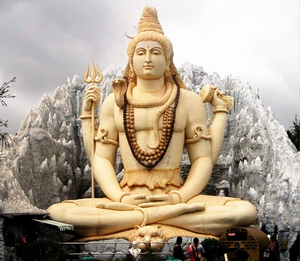Shravan Month Rituls
It is also known as Upakarma or Rishitarpan. The ritual of Shravani is associated with the learning of the Vedas. Two rituals performed associated with the learning of Vedas are
Utsarjan ritual, that is, giving up of the Vedas
Upakarma ritual, that is, accepting of the Veda
Upakarma vidhi is performed before commencing learning of Vedas. On the day of Shravani the sequence of studies for the next year is determined only after performing the Upakarma vidhi. If the learning of Vedas is to be discontinued, the Utsarjan vidhi is performed.
Utsarjan ritual
On the day of Shravani, the presiding brahmin takes his seat after ablutions in the morning. A sacrificial fire pit is created for Utsarjan-karma (temporary giving up of the Vedas for earning a living) and a similar one for Upakarma (resuming learning of the Vedas). First a ring of Darbh (holy grass) is worn and along with uttering of the desh-kal, resolve (sankalp) is made.
After this panch-gavya is consumed. Panch-gavya is a mixture of milk, curd, ghee, cow’s urine and cowdung.
Then ritualistic worship of Mahaganapati is done.
Utsarjan hom (fire sacrifice) is then performed.
Thereafter, oblations of ghee and cooked rice are offered to the deities in the sacrificial fire.
Ritualistic Bathing: In ritualistic bathing, the body is purified by bathing using holy ash (bhasma-snan), cowdung (Gomay-snan), mud (mruttika-snan) and water.
The body benefits from the Absolute Fire Element (Tej-tattva) by applying holy ash.
The body benefits from the Absolute Air Element (Vayu-tattva) by applying cowdung.
By applying mud the body benefits from the Absolute Earth Element (Pruthvi-tattva).
Also due to application of the frequencies of the principles of holy ash, cowdung and mud on the body, a covering is formed and the black covering is removed.
Then holy grass (durva), sesame seeds and mud is placed on the head along with uttering of mantras.
Spiritual experiences: Some spiritual experiences of the seekers who participated in the Shravani ritual with spiritual emotion:
1. Black energy going out of the body through yawning and burping
2. Experiencing lightness in the body
3. Fragrance emanating from the body
4. Mind becoming stable and introverted
5. Enhancing of concentration of the mind
It is clear from the above points that by purifying the body ritualistically in this way together with uttering of mantras, the mind also starts getting purified.
Worshipping the Sages and giving offerings (tarpan) to the Sages
Here eight betel-nuts (suparis) are placed on a short wooden stool. Then the seven Sages namely Kashyap, Atri, Bhardwaj, Gautam,Jamdagni, Vasishtha, Vishwamitra and Arundhati are invoked and worshipped.
After this, by keeping the sacred thread on both the shoulders, offerings (tarpan) are given to the Sages.
Seven circles are created from the region of the Sages. These circles become one at the nirgun level to form a flow. This flow is emitted towards the Earth and is attracted at the place of the ritualistic worship of the Sages. Through this flow fountains of frequencies ofChaitanya spread in the environment. The people present there benefit from it.
Upakarma ritual
In this ritual oblations are offered in the sacrificial fire. In this balls are made from the barley flour and offered in the fire. Then the person participating in the Shravani ritual swallows the balls made from barley flour without chewing.
Adorning a new sacred thread (yadnyopaveet)
In the ritual of adorning the sacred thread, first the sacred thread is enriched by uttering mantras. By uttering the mantras with spiritual emotion the vibrations of spiritual energy emitted from the four Vedas are attracted towards the sacred thread and they revolve around it in an activated form.
The sacred thread is held in the hands and the Gayatri mantra is uttered. Then with prayers and spiritual emotion it is adorned. Then the old sacred thread is discarded. The subtle effect of adorning the sacred thread is as follows:
1. Through this spiritual energy is activated in the sacred thread and it gets charged with this energy.
2. Spiritual emotion is awakened in the person who adorns the sacred thread
2a. The person achieves communion with God.
3. A flow of God’s blessings in the form of Chaitanya is attracted towards the person.
3a. Chaitanya is activated in his body.
4. A flow of Divine Energy of Knowledge is attracted.
4a. A spiral of Energy of Knowledge is created at the Adnya chakra of the person who wears the sacred thread
5. Through the spiral of Energy of Knowledge a flow of Energy of wisdom (pradnya-shakti) spreads at the place of Anahat-chakra of the person.
5a. A spiral of Energy of wisdom is created in the person’s body.
6. A flow of Divine Chetana-shakti is attracted towards the person.
6a. Through this flow a spiral of Chetana-shakti is created in his body.
6b. Flows of Chetana-shakti spread in his body.
6c. Also particles of Chaitanya-like energy spread in his body. Due to the Chetana-shakti generated in the body, the person acquires the energy to study the Vedas.
7. The seven Kundalini chakras in his body get activated.
8. A protective sheath is created around the body.
9. He is protected from negative energies.







